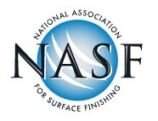The course consists of 11 lessons. Each one contains a wealth of valuable, practical information. And if you score 70 or above on the optional exam, you’ll receive 1 credit toward certification as a Master Surface Finisher. MSF is the world’s most respected – and most widely recognized – designation for finishing industry professionals. Those passing 6 course exams earn the coveted MSF designation.
Course Options
Web-Based
Dates: September: 3, 4, 10, 11, 17, 18, 24, 25, October: 1, 2, 8, 9, 15, 16, 22, 23
Registration Deadline: August 27, 2024
Member: $975 | Non-Member: $1300Home-Study
Member: $1,100 | Non-Member: $1,500
Optional Exam
Member: $200 | Non-Member: $300
Who Benefits?
This training program is beneficial for employees and supervisors who work in captives or job shops that apply anodizing and other finishing processes to aluminum.
Goal:
The goal of this course is to provide the student with a broad range of information related to metal finishing processes that are used on aluminum.
Course Description
- 1. The Metallurgy of Aluminum
This lesson covers the basic properties of aluminum, also the methods used to produce parts from aluminum, and their impact on finishing.
Students will learn about forging, die casting, stamping, extruding and drawing of aluminum. Also covered is the subject of alloying elements and their impact on the surface finish following anodizing. The differences between 1000, 2000, 3000, 4000, 5000, 6000 and 7000 series alloys are detailed.
- 2. Mechanical Finishing of Aluminum
- This lesson covers mechanical means of finishing aluminum parts, including grinding, polishing, buffing, vibratory finishing, shot peening and blasting. The differences between various polishing compounds and media are provided along with a basic understanding of the differences between polishing hardware.
- 3. Preparing Aluminum for Anodizing and Plating
- This lesson details the steps used to prepare aluminum for anodizing or chem film (chromate) conversion coating. Cleaning via ultrasonic, chemical soak, and electro-cleaning is discussed. Special attention is given to the use of deoxidizing solutions and various acid dip mixtures. Newer technologies such as the use of biological cleaners are also discussed. A significant amount of material on the zincate process for plating on aluminum is included in this lesson.
- 4. Aluminum Bright Dips and Electropolishing
- This lesson covers the various solutions and methods used to brighten the surface of aluminum prior to finishing. Included is a discussion of electropolishing equipment and phosphoric-sulfuric electropolishing solutions. The section on bright dipping covers equipment solutions and process troubleshooting.
- 5. Etching and Chemical Milling of Aluminum
In this lesson, students will be provided with an overview of the various methods of etching and chemical milling of aluminum using alkaline and acidic solutions, with emphasis on the use of sodium hydroxide.
Operational conditions that affect etching and milling rates and the ultimate dimensions of the parts are provided. The hazardous nature of the etching process is discussed, with an example of a hydrogen explosion related to an etching process at a European anodizing facility.
- 6. Equipment Requirements for Anodizing
- This lesson covers design issues related to the individual components of an anodizing process, including tanks, rectification, cathodes, filtration, racking, agitation systems, and process ventilation. A brief discussion of coil anodizing and brush anodizing is also part of this lesson.
- 7. Sulfuric Acid Anodizing of Aluminum
This lesson covers the MIL-A 8625 Type II anodizing process. Solution make-up and operational conditions including the role of impurities are discussed in detail. Common problems with the process and possible solutions are also provided.
A brief discussion on methods used to measure and monitor anodic thickness and coatings weight is also covered. A section on “keys to successful bright anodizing” may be of special use to decorative anodizing facilities.
- 8. Coloring and Sealing of Anodized Aluminum
This lesson provides guidance for coloring anodic coatings using immersion dye, electrolytic methods and integral (two-step) color anodizing. Operational conditions for obtaining the best results are provided as well as a discussion of the merits of each technique.
The lesson also provides descriptions of the most popular methods of sealing anodic coatings, including nickel acetate, hot water and dichromate sealing, low temperature sealing and two-step sealing. A discussion of seal quality tests is also provided.
Decorative anodizers will find the “keys to successful dyeing” and “keys to successful nickel salt sealing” sections very useful in focusing on the most important operational variables in a dye tank.
- 9. Hardcoat & Alternate Anodizing Solutions
- This lesson will detail the most common methods for obtaining MIL-A 8625 Type III coatings. Included are the Martin, MAE, Hardas, Sanford and Metalast hard coating processes. A discussion of operational parameters affecting wear resistance is provided. The Taber abrasion resistance test is also discussed, along with a brief discussion of alternate hardcoat anodizing solutions.
- 10. Anodizing Aluminum in Chromic Acid and Alternate Solutions
- This lesson details the MIL-A 8625 Type I (chromic acid), LC (sulfuric-boric acid) and LLB (thin film sulfuric acid) anodizing processes. Solution make-up, operational conditions and a discussion of the role of impurities are included, along with the different results obtained from various alloys.
- 11. Conversion Coatings on Aluminum
- This lesson provides operational and troubleshooting guidance for processes that produce chromate type (Alodine® and Iridite®) films on aluminum. Solution makeup and operational conditions for maximizing results are provided. Discussion of the causes of salt spray failures, European WEEE and RoHS initiatives and non-chromated conversion coatings are explored.
